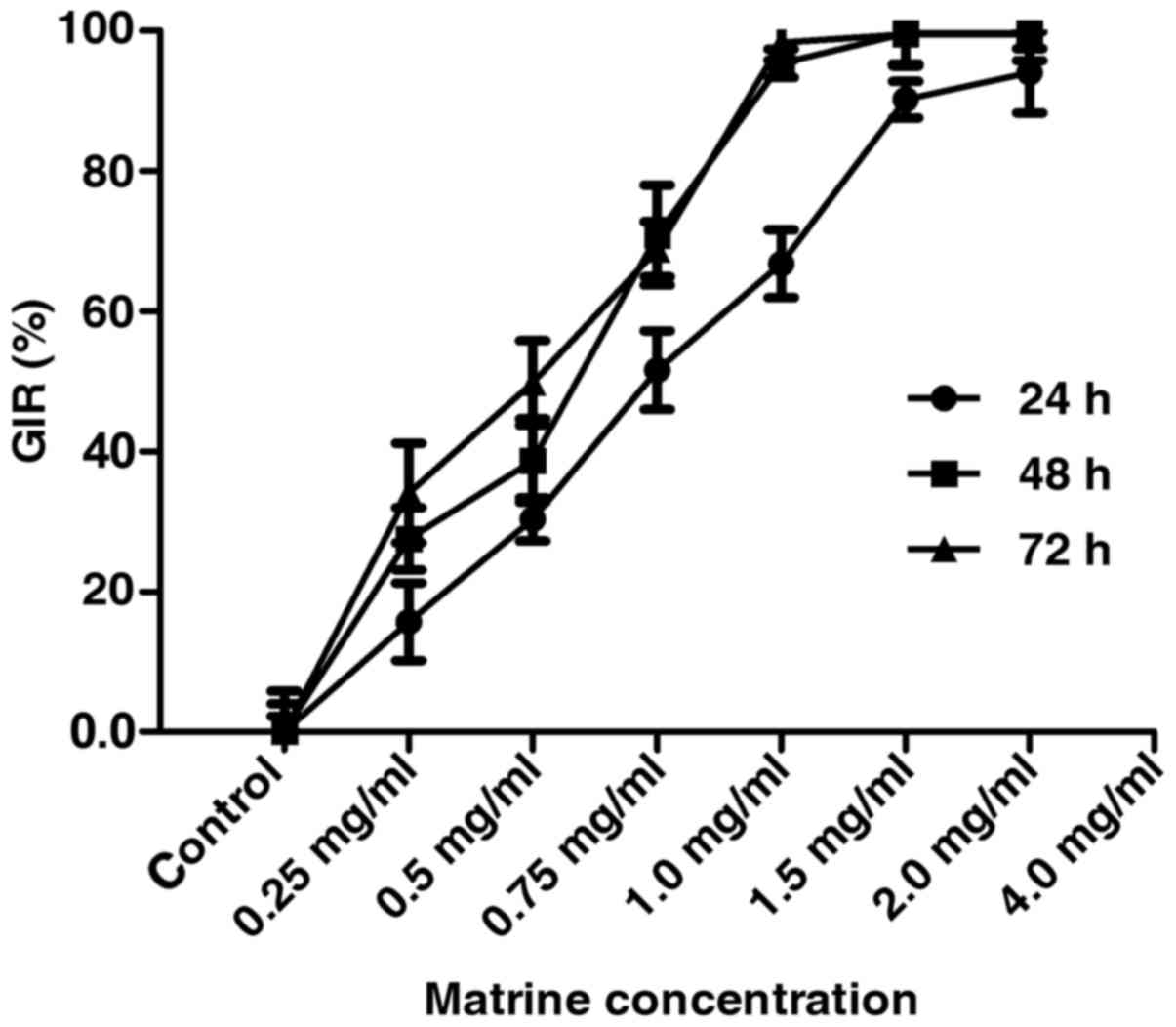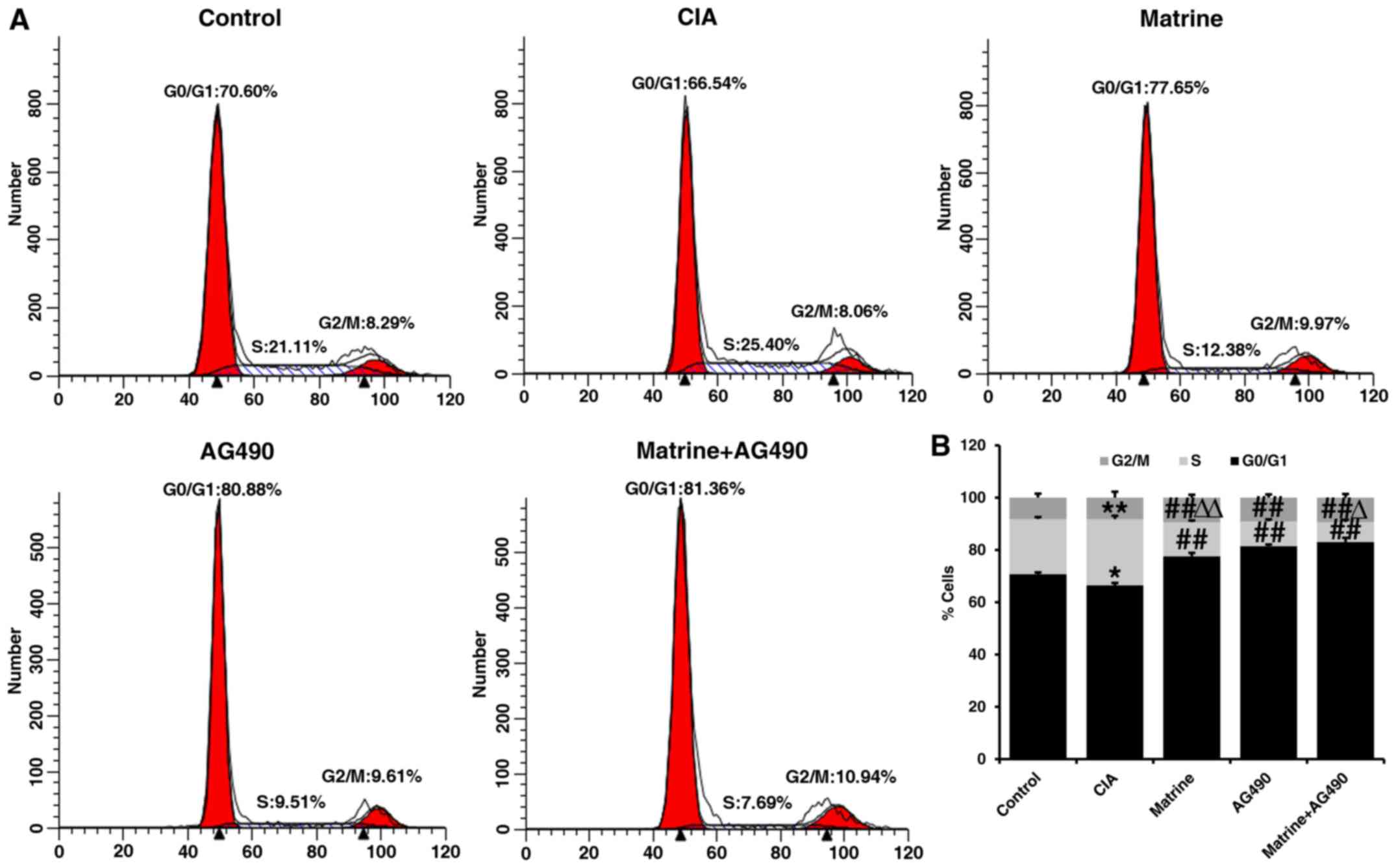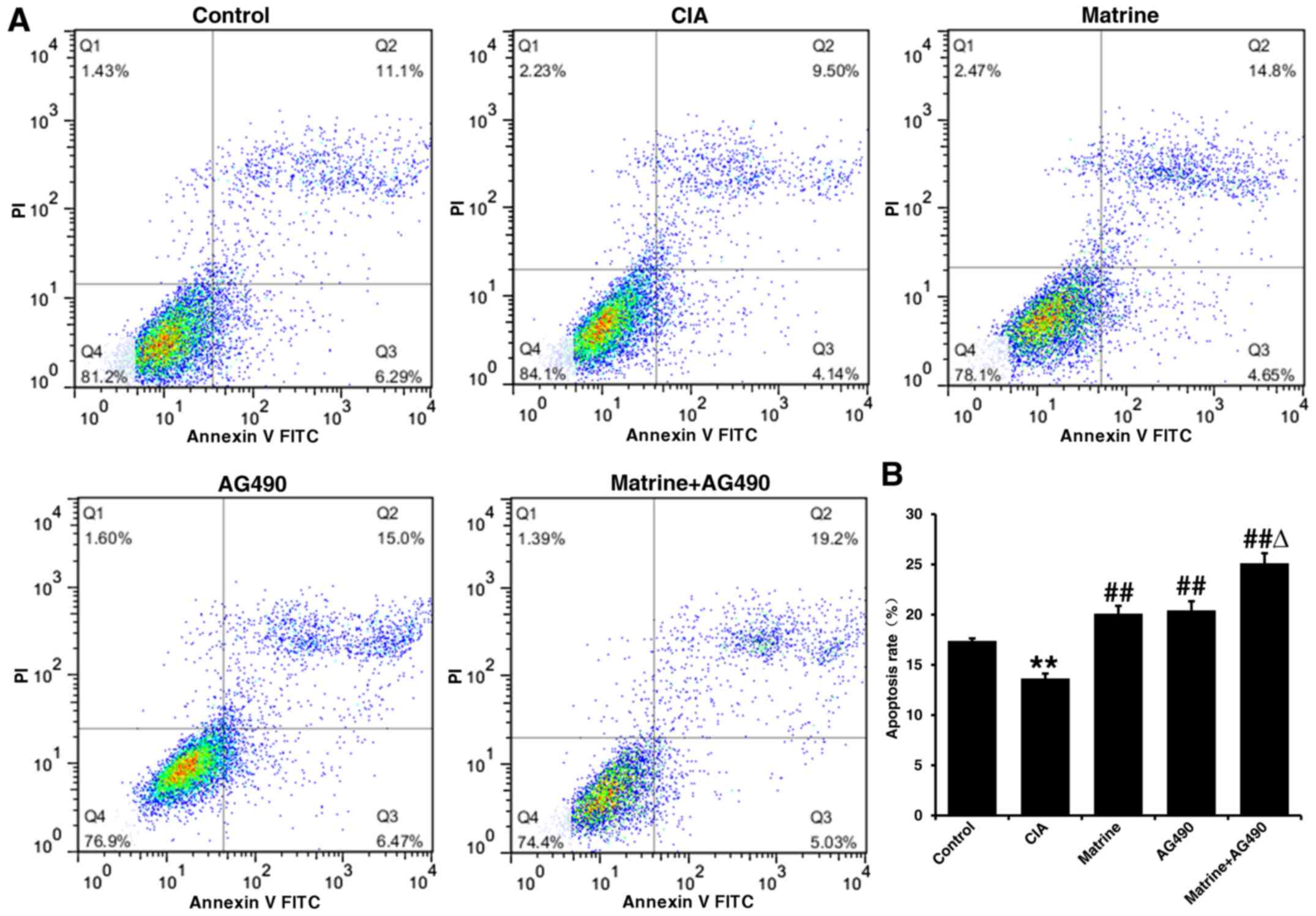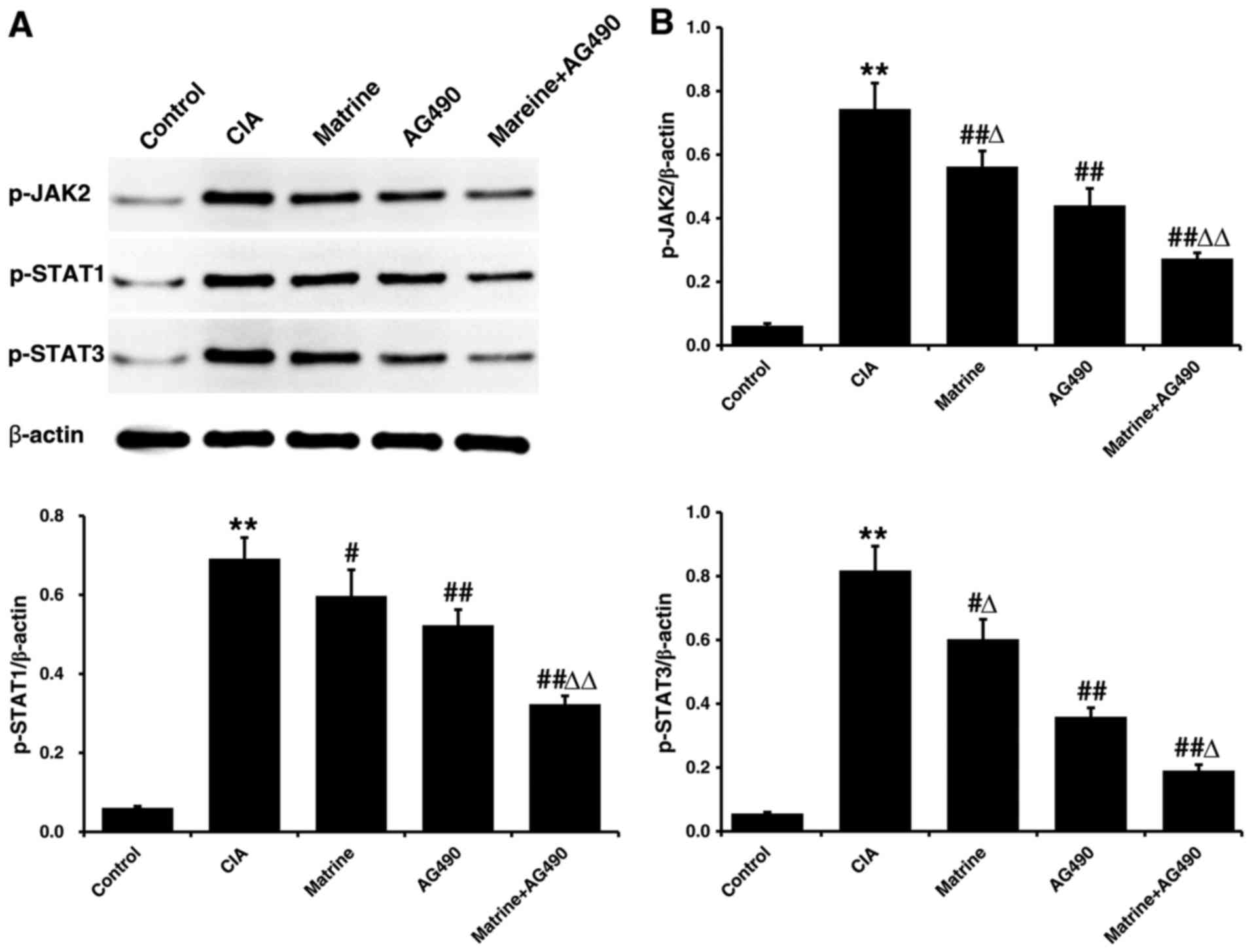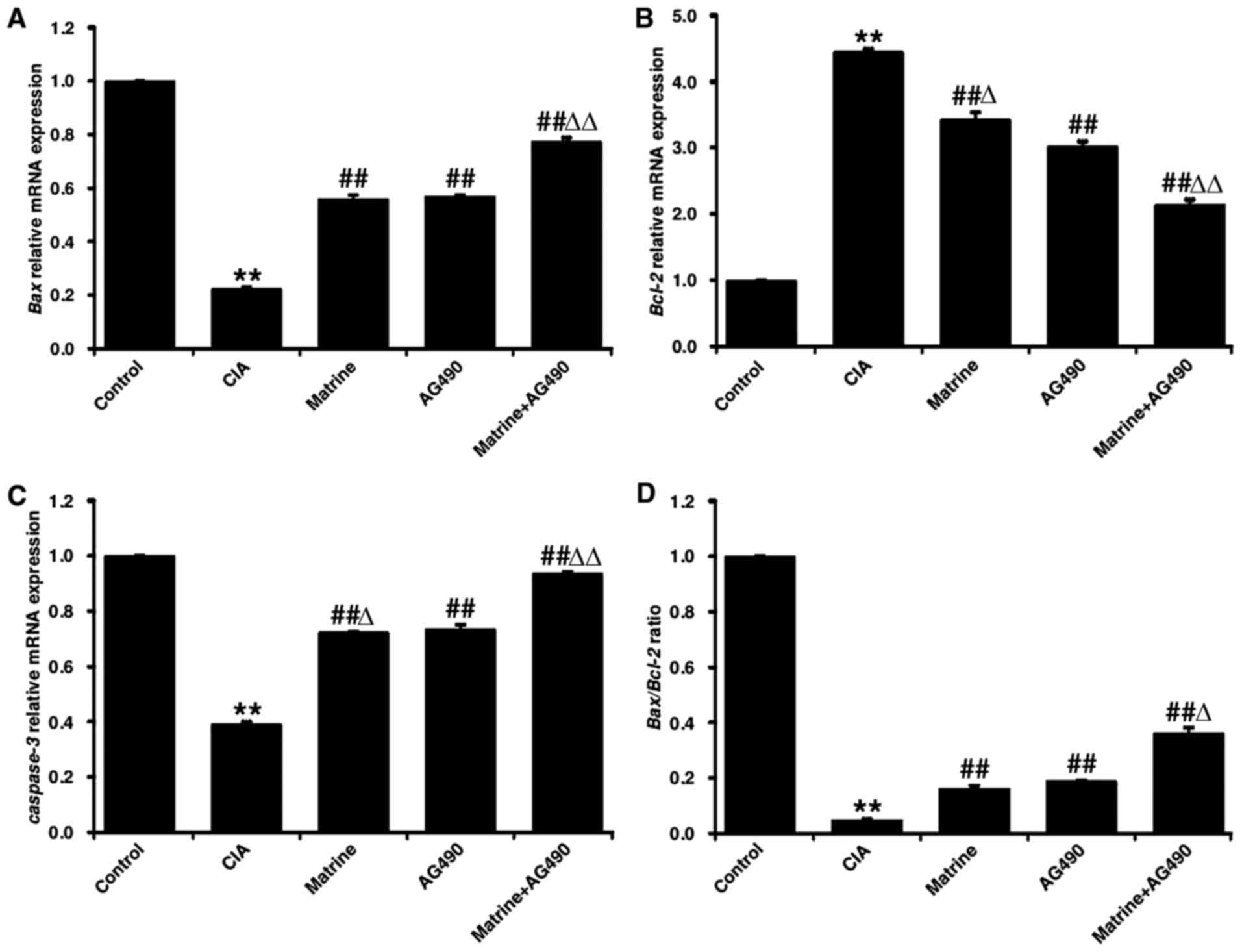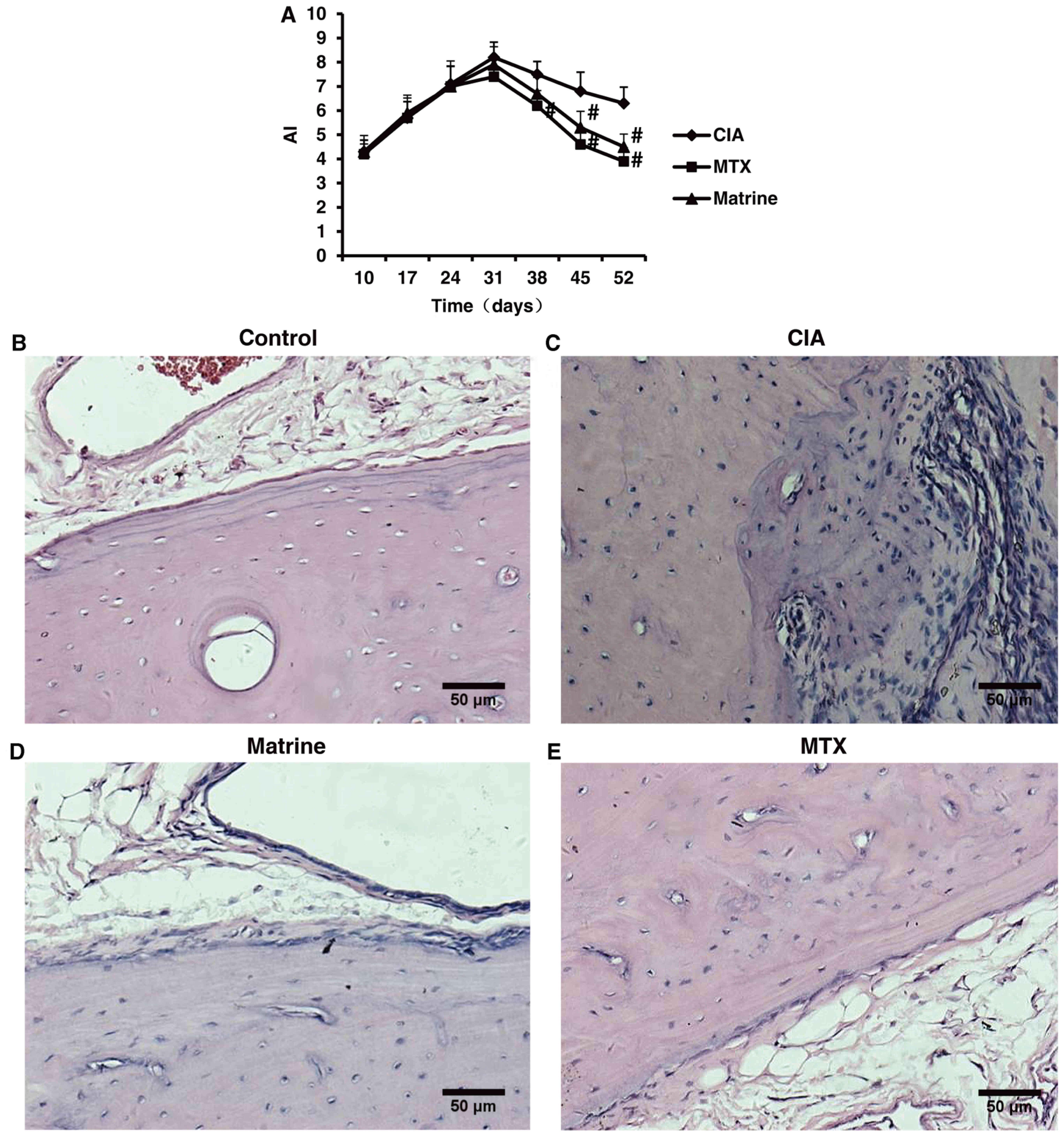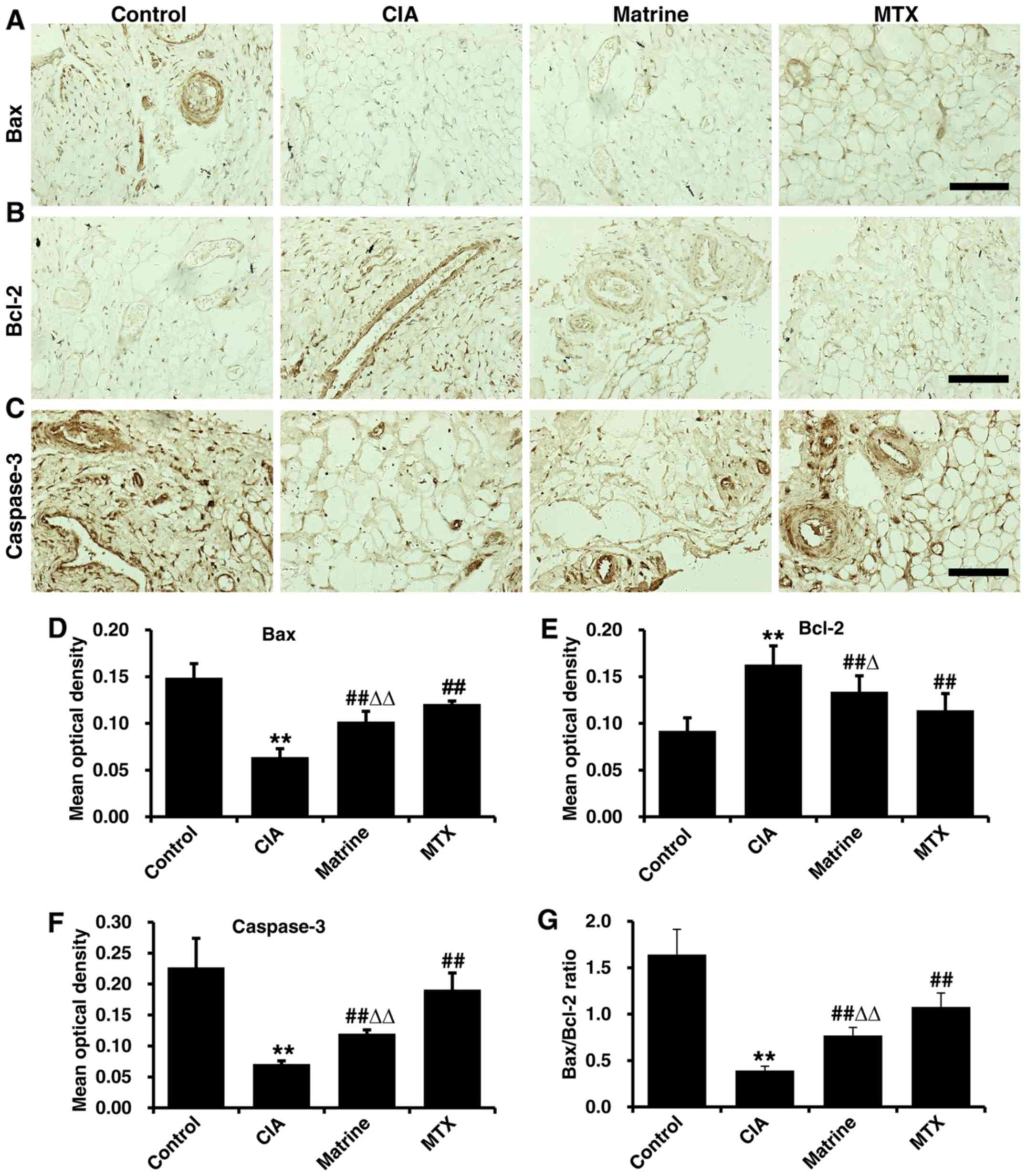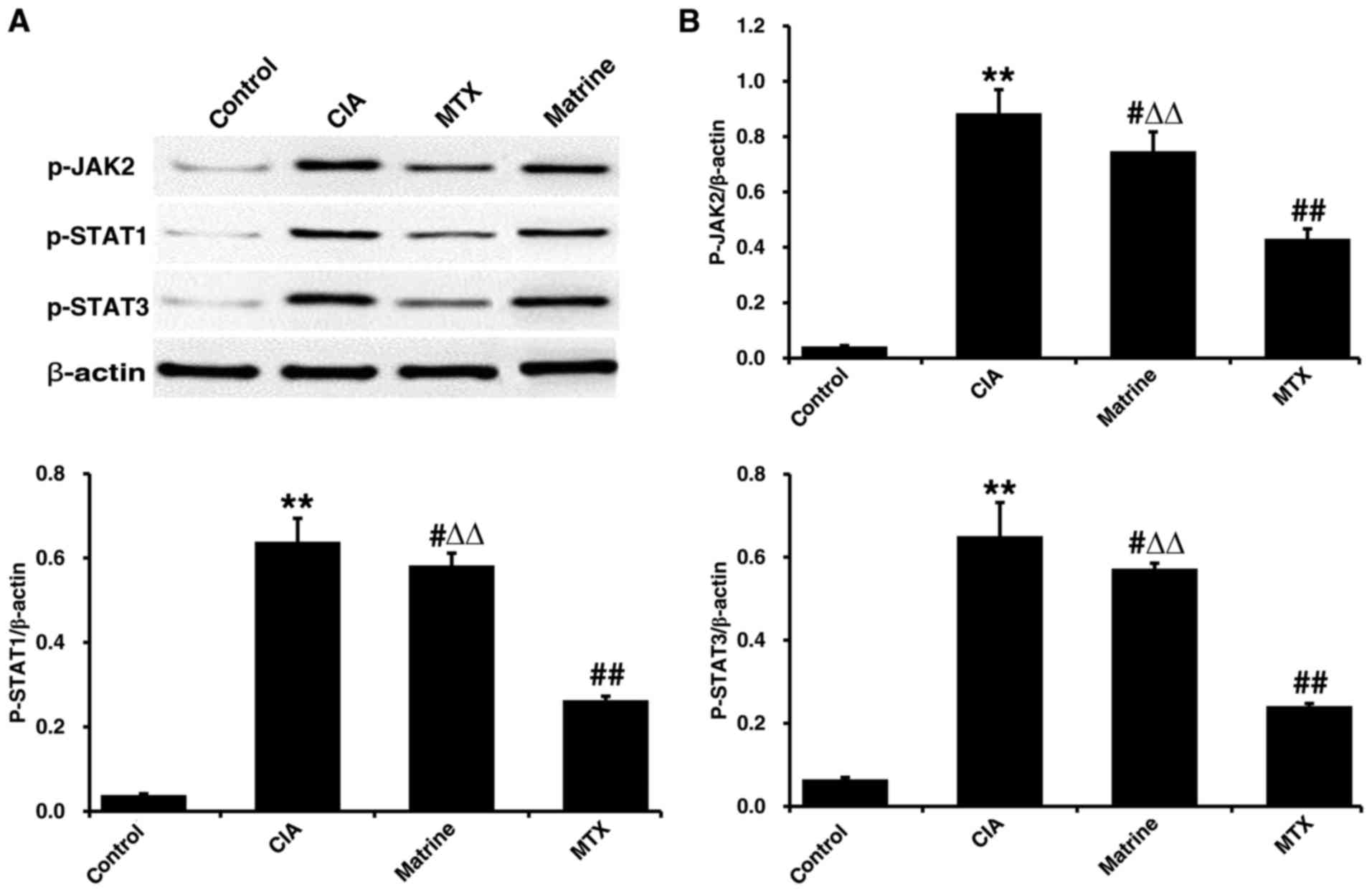|
1
|
Zhang W, Zhu J, Du Z, Yu J, Xu Y and Wang
F: Intraarticular gene transfer of SPRY2 suppresses
adjuvant-induced arthritis in rats. Appl Microbiol Biotechnol.
99:6727–6735. 2015. View Article : Google Scholar : PubMed/NCBI
|
|
2
|
Liu H, Yang Y, Cai X, Gao Y, Du J and Chen
S: The effects of arctigenin on human rheumatoid arthritis
fibroblast-like synoviocytes. Pharm Biol. 53:1118–1123. 2015.
View Article : Google Scholar : PubMed/NCBI
|
|
3
|
Tamai M, Kawakami A, Tanaka F, Miyashita
T, Nakamura H, Iwanaga N, Izumi Y, Arima K, Aratake K, Huang M, et
al: Significant inhibition of TRAIL-mediated fibroblast-like
synovial cell apoptosis by IFN-gamma through JAK/STAT pathway by
translational regulation. J Lab Clin Med. 147:182–190. 2006.
View Article : Google Scholar : PubMed/NCBI
|
|
4
|
Zong M, Lu T, Fan S, Zhang H, Gong R, Sun
L, Fu Z and Fan L: Glucose-6-phosphate isomerase promotes the
proliferation and inhibits the apoptosis in fibroblast-like
synoviocytes in rheumatoid arthritis. Arthritis Res Ther.
17:1002015. View Article : Google Scholar : PubMed/NCBI
|
|
5
|
Huang M, Zeng S, Qiu Q, Xiao Y, Shi M, Zou
Y, Yang X, Xu H and Liang L: Niclosamide induces apoptosis in human
rheumatoid arthritis fibroblast-like synoviocytes. Int
Immunopharmacol. 31:45–49. 2016. View Article : Google Scholar
|
|
6
|
Coskun M, Salem M, Pedersen J and Nielsen
OH: Involvement of JAK/STAT signaling in the pathogenesis of
inflammatory bowel disease. Pharmacol Res. 76:1–8. 2013. View Article : Google Scholar : PubMed/NCBI
|
|
7
|
Seavey MM and Dobrzanski P: The many faces
of Janus kinase. Biochem Pharmacol. 83:1136–1145. 2012. View Article : Google Scholar : PubMed/NCBI
|
|
8
|
Ghoreschi K, Laurence A and O'Shea JJ:
Selectivity and therapeutic inhibition of kinases: to be or not to
be? Nat Immunol. 10:356–360. 2009. View
Article : Google Scholar : PubMed/NCBI
|
|
9
|
Kim SK, Park KY, Yoon WC, Park SH, Park
KK, Yoo DH and Choe JY: Melittin enhances apoptosis through
suppression of IL-6/sIL-6R complex-induced NF-κB and STAT3
activation and Bcl-2 expression for human fibroblast-like
synoviocytes in rheumatoid arthritis. Joint Bone Spine. 78:471–477.
2011. View Article : Google Scholar : PubMed/NCBI
|
|
10
|
Kasperkovitz PV, Verbeet NL, Smeets TJ,
van Rietschoten JG, Kraan MC, van der Pouw Kraan TC, Tak PP and
Verweij CL: Activation of the STAT1 pathway in rheumatoid
arthritis. Ann Rheum Dis. 63:233–239. 2004. View Article : Google Scholar : PubMed/NCBI
|
|
11
|
Krause A, Scaletta N, Ji JD and Ivashkiv
LB: Rheumatoid arthritis synoviocyte survival is dependent on
Stat3. J Immunol. 169:6610–6616. 2002. View Article : Google Scholar : PubMed/NCBI
|
|
12
|
Wang H, Fang Y, Wang Y, Wang Z, Zou Q, Shi
Y, Chen J and Peng D: Inhibitory effect of curcumol on Jak2-STAT
signal pathway molecules of fibroblast-like synoviocytes in
patients with rheumatoid arthritis. Evid Based Complement Alternat
Med. 2012:7464262012.PubMed/NCBI
|
|
13
|
Culshaw S, McInnes IB and Liew FY: What
can the periodontal community learn from the pathophysiology of
rheumatoid arthritis? J Clin Periodontol. 38(Suppl 11): 106–113.
2011. View Article : Google Scholar : PubMed/NCBI
|
|
14
|
Lee WS, Lim JH, Sung MS, Lee EG, Oh YJ and
Yoo WH: Ethyl acetate fraction from Angelica sinensis inhibits
IL-1β-induced rheumatoid synovial fibroblast proliferation and
COX-2, PGE2, and MMPs production. Biol Res. 47:412014. View Article : Google Scholar
|
|
15
|
Xin W, Huang C, Zhang X, Xin S, Zhou Y, Ma
X, Zhang D, Li Y, Zhou S, Zhang D, et al: Methyl salicylate
lactoside inhibits inflammatory response of fibroblast-like
synoviocytes and joint destruction in collagen-induced arthritis in
mice. Br J Pharmacol. 171:3526–3538. 2014. View Article : Google Scholar : PubMed/NCBI
|
|
16
|
Wu Y, Wang Y, Zhang Y, Chen LP and Wang
JY: Effect of matrine on NO and ADMA metabolism pathways in serum
and tissues of mice with lipopolysaccharide-induced intestine
tissue inflammation. Zhongguo Zhong Yao Za Zhi. 39:2318–2321.
2014.In Chinese. PubMed/NCBI
|
|
17
|
Yang N, Han F, Cui H, Huang J, Wang T,
Zhou Y and Zhou J: Matrine suppresses proliferation and induces
apoptosis in human cholangiocarcinoma cells through suppression of
JAK2/STAT3 signaling. Pharmacol Rep. 67:388–393. 2015. View Article : Google Scholar : PubMed/NCBI
|
|
18
|
Sun N, Wang ZW, Wu CH, Li E, He JP, Wang
SY, Hu YL, Lei HM and Li HQ: Antiviral activity and underlying
molecular mechanisms of matrine against porcine reproductive and
respiratory syndrome virus in vitro. Res Vet Sci. 96:323–327. 2014.
View Article : Google Scholar : PubMed/NCBI
|
|
19
|
Yu JL, Li JH, Chengz RG, Ma YM, Wang XJ
and Liu JC: Effect of matrine on transforming growth factor β1 and
hepatocyte growth factor in rat liver fibrosis model. Asian Pac J
Trop Med. 7:390–393. 2014. View Article : Google Scholar : PubMed/NCBI
|
|
20
|
Zhou Y, Wu Y, Deng L, Chen L, Zhao D, Lv
L, Chen X, Man J, Wang Y, Shan H, et al: The alkaloid matrine of
the root of Sophora flavescens prevents arrhythmogenic effect of
ouabain. Phytomedicine. 21:931–935. 2014. View Article : Google Scholar : PubMed/NCBI
|
|
21
|
Fu Q, Wang J, Ma Z and Ma S:
Anti-asthmatic effects of matrine in a mouse model of allergic
asthma. Fitoterapia. 94:183–189. 2014. View Article : Google Scholar
|
|
22
|
Liu N, Kan QC, Zhang XJ, Xv YM, Zhang S,
Zhang GX and Zhu L: Upregulation of immunomodulatory molecules by
matrine treatment in experimental autoimmune encephalomyelitis. Exp
Mol Pathol. 97:470–476. 2014. View Article : Google Scholar : PubMed/NCBI
|
|
23
|
Yuan X, Garrett-Sinha LA, Sarkar D and
Yang S: Deletion of IFT20 in early stage T lymphocyte
differentiation inhibits the development of collagen-induced
arthritis. Bone Res. 2:140382014. View Article : Google Scholar : PubMed/NCBI
|
|
24
|
Caplazi P, Baca M, Barck K, Carano RA,
DeVoss J, Lee WP, Bolon B and Diehl L: Mouse models of rheumatoid
arthritis. Vet Pathol. 52:819–826. 2015. View Article : Google Scholar : PubMed/NCBI
|
|
25
|
Ota F, Maeshima A, Yamashita S, Ikeuchi H,
Kaneko Y, Kuroiwa T, Hiromura K, Ueki K, Kojima I and Nojima Y:
Activin A induces cell proliferation of fibroblast-like
synoviocytes in rheumatoid arthritis. Arthritis Rheum.
48:2442–2449. 2003. View Article : Google Scholar : PubMed/NCBI
|
|
26
|
Zhang WD, Wang PM, Han RX and Zhang TS:
Efficacy and safety evaluation of fire needling for rats with
rheumatoid arthritis. Zhongguo Zhen Jiu. 33:334–338. 2013.In
Chinese. PubMed/NCBI
|
|
27
|
Baharav E, Mor F, Halpern M and Weinberger
A: Lactobacillus GG bacteria ameliorate arthritis in Lewis rats. J
Nutr. 134:1964–1969. 2004.PubMed/NCBI
|
|
28
|
Yan C, Kong D, Ge D, Zhang Y, Zhang X, Su
C and Cao X: Mitomycin C induces apoptosis in rheumatoid arthritis
fibroblast-like synoviocytes via a mitochondrial-mediated pathway.
Cell Physiol Biochem. 35:1125–1136. 2015. View Article : Google Scholar : PubMed/NCBI
|
|
29
|
Zheng CJ, Zhao XX, Ai HW, Lin B, Han T,
Jiang YP, Xing X and Qin LP: Therapeutic effects of standardized
Vitex negundo seeds extract on complete Freund's adjuvant induced
arthritis in rats. Phytomedicine. 21:838–846. 2014. View Article : Google Scholar : PubMed/NCBI
|
|
30
|
Wang M, Li K, Nie Y, Wei Y and Li X:
Antirheumatoid arthritis activities and chemical compositions of
phenolic compounds-rich fraction from Urtica atrichocaulis, an
endemic plant to China. Evid Based Complement Alternat Med.
2012:8182302012.
|
|
31
|
Shao Q, Zhao X and Yao L: Matrine inhibits
the growth of retinoblastoma cells (SO-Rb50) by decreasing
proliferation and inducing apoptosis in a mitochondrial pathway.
Mol Biol Rep. 41:3475–3480. 2014. View Article : Google Scholar : PubMed/NCBI
|
|
32
|
Shi M, Cui F, Liu AJ, Ma HJ, Cheng M, Song
SX, Yuan F, Li DP and Zhang Y: The protective effects of chronic
intermittent hypobaric hypoxia pretreatment against
collagen-induced arthritis in rats. J Inflamm (Lond). 12:232015.
View Article : Google Scholar
|
|
33
|
Luo Y, Wei Z, Chou G, Wang Z, Xia Y and
Dai Y: Noriso-boldine induces apoptosis of fibroblast-like
synoviocytes from adjuvant-induced arthritis rats. Int
Immunopharmacol. 20:110–116. 2014. View Article : Google Scholar : PubMed/NCBI
|
|
34
|
Correia C, Lee SH, Meng XW, Vincelette ND,
Knorr KL, Ding H, Nowakowski GS, Dai H and Kaufmann SH: Emerging
understanding of Bcl-2 biology: implications for neoplastic
progression and treatment. Biochim Biophys Acta. 1853:1658–1671.
2015. View Article : Google Scholar : PubMed/NCBI
|
|
35
|
Bartok B and Firestein GS: Fibroblast-like
synoviocytes: key effector cells in rheumatoid arthritis. Immunol
Rev. 233:233–255. 2010. View Article : Google Scholar : PubMed/NCBI
|
|
36
|
Lee SY, Kwok SK, Son HJ, Ryu JG, Kim EK,
Oh HJ, Cho ML, Ju JH, Park SH and Kim HY: IL-17-mediated Bcl-2
expression regulates survival of fibroblast-like synoviocytes in
rheumatoid arthritis through STAT3 activation. Arthritis Res Ther.
15:R312013. View
Article : Google Scholar : PubMed/NCBI
|
|
37
|
Jie L, Du H, Huang Q, Wei S, Huang R and
Sun W: Tanshinone IIA induces apoptosis in fibroblast-like
synoviocytes in rheumatoid arthritis via blockade of the cell cycle
in the G2/M phase and a mitochondrial pathway. Biol Pharm Bull.
37:1366–1372. 2014. View Article : Google Scholar : PubMed/NCBI
|
|
38
|
Yeh CT, Huang WC, Rao YK, Ye M, Lee WH,
Wang LS, Tzeng DT, Wu CH, Shieh YS, Huang CY, et al: A
sesquiterpene lactone antrocin from Antrodia camphorata negatively
modulates JAK2/STAT3 signaling via microRNA let-7c and induces
apoptosis in lung cancer cells. Carcinogenesis. 34:2918–2928. 2013.
View Article : Google Scholar : PubMed/NCBI
|
|
39
|
Shouda T, Yoshida T, Hanada T, Wakioka T,
Oishi M, Miyoshi K, Komiya S, Kosai K, Hanakawa Y, Hashimoto K, et
al: Induction of the cytokine signal regulator SOCS3/CIS3 as a
therapeutic strategy for treating inflammatory arthritis. J Clin
Invest. 108:1781–1788. 2001. View Article : Google Scholar : PubMed/NCBI
|
|
40
|
Liu H and Pope RM: The role of apoptosis
in rheumatoid arthritis. Curr Opin Pharmacol. 3:317–322. 2003.
View Article : Google Scholar : PubMed/NCBI
|
|
41
|
Li GF, Qin YH and Du PQ: Andrographolide
inhibits the migration, invasion and matrix metalloproteinase
expression of rheumatoid arthritis fibroblast-like synoviocytes via
inhibition of HIF-1α signaling. Life Sci. 136:67–72. 2015.
View Article : Google Scholar : PubMed/NCBI
|




